Tunesien, das Offroad-Paradies, lockt Abenteurer mit endlosen Weiten und der wilden Sahara. Entdecke die atemberaubende Natur und Sehenswürdigkeiten in dieser unzugänglichen Region. Unsere 4x4 Tunesien-Reise führt durch die faszinierenden Landschaften des Landes. Erlebe die Ausläufer des Atlas und die großen Salzseen, bevor wir in die Sahara eintauchen. Mit dem Geländewagen erkunden wir Dünen und Oasen, erleben den Sonnenuntergang über der Sahara und genießen die Freiheit, solange der Horizont reicht. Ein unvergessliches Offroad-Abenteuer erwartet dich. Finde deine Freiheit in der Sahara!
Tunesien ist für Abenteuerer das Offroad Paradies pur. Ein Urlaub mit dem Fokus "Freiheit so lange der Horizont reicht".
Tunesien, auch die "Schweiz von Nordafrika" genannt, ist ein Land, in dem sich der Massentourismus auf die Hotelburgen an der Mittelmeerküste konzentriert. Das Abenteuer ist freilich in der endlos scheinenden und schwer zugänglichen Region der Sahara. Im Landesinneren Tunesiens lebt nur ein Fünftel der Landesbevölkerung, welches mit ihren Sehenswürdigkeiten aus einer längst vergangenen Zeit und einer atemberaubenden Natur in der freien, wilden Wüste unermesslich schön ist.
Willkommen bei unserer offroad Reise zwischen Zivilisation und der endlosen Sahara!
Start zur 4x4 Tunesien Reise: Tübingen - Genua - Fähre nach Afrika:
Alle Teilnehmer erhalten vor der Tour eine Infomappe mit Treffpunkt, Beschreibungen und 4x4 Camping Ausrüstung / Vorbereitungsliste für die 4x4 Reise in die Sahara.
Anreise und Treffen zur 4x4 Tunesien Reise:
- Treffpunkt: Das OVERCROSS Off Road Team startet am ersten Tag der Reise (Samstag) früh morgens von Tübingen über die Schweiz nach Italien
- Treffpunkt für Teilnehmer aus der Schweiz ist an einer Tankstelle nahe der Autobahn
- Letzter Treffpunkt der 4x4 Tunesien Reise ist dann am frühen Nachmittag im Fährhafen von Genua, wo Ihr alle Dokumente und Kabinen Tickets vom OVERCROSS Tourguide ausgehändigt bekommt.
Reiseverlauf zur Offroad Pur - auf Spurensuche in der Sahara:
Geländewagenreise Tag 1: Tunis - Hammamet
In Tunis angekommen, fahren wir von der Fähre und erledigen so schnell es geht die Einreiseformalitäten für uns und die Fahrzeuge. Anschließend fahren wir zu unserem ersten Hotel auf der Tour und nehmen ein erfrischendes Bad im Golf von Hammamet, bevor es am nächsten Tag in Richtung Süden geht.
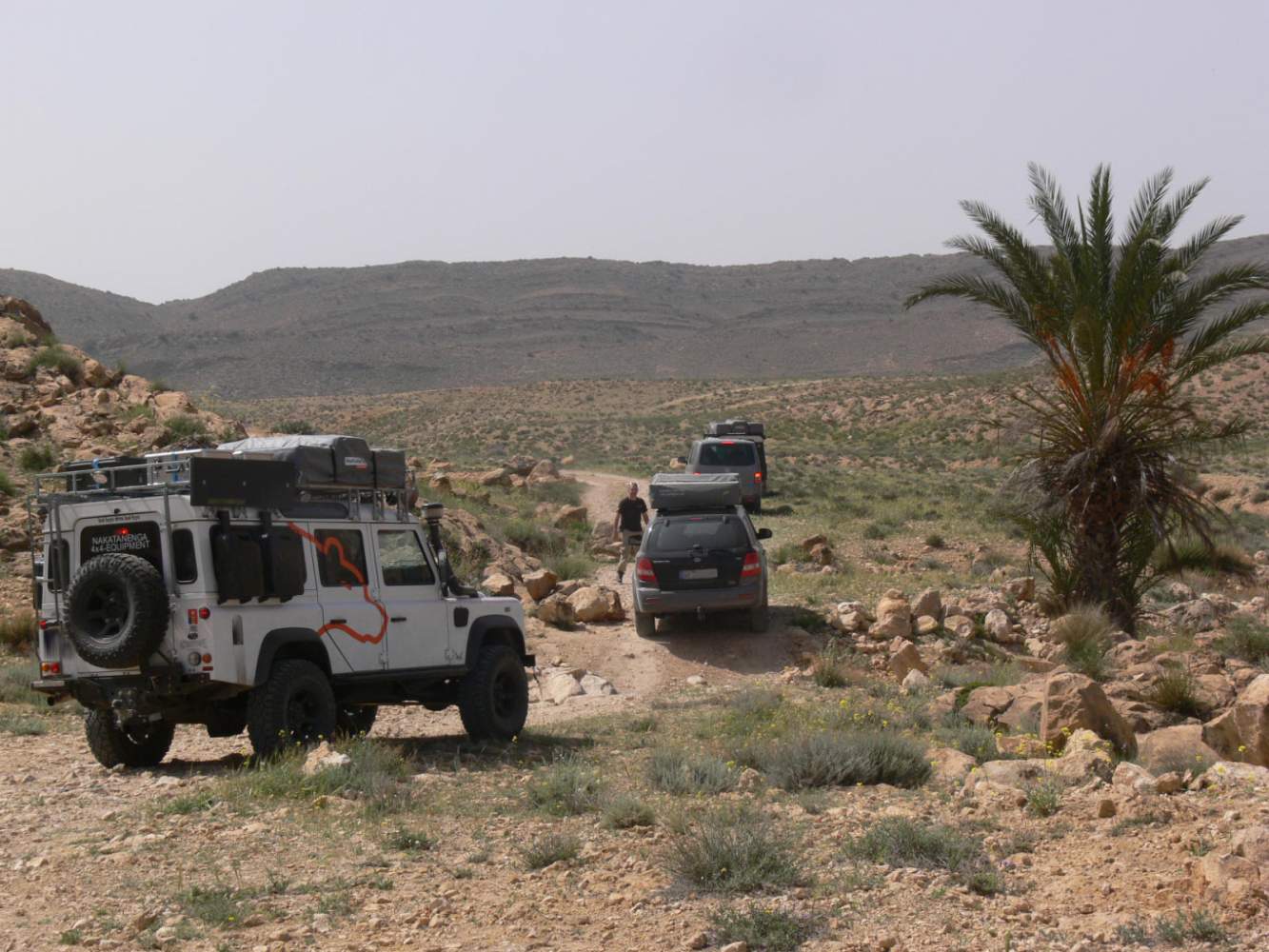
Mit dem Defender auf der Offroad Pur Auf Spurensuche in der Sahara
Geländewagenreise Tag 2: Hammamet - Gafsa
Um Strecke zu machen, damit wir schnell in den landschaftlich und fahrerisch abwechslungsreicheren Süden kommen, wird die heutige Etappe der Offroad Pur Auf Spurensuche in der Sahara zum Großteil auf befestigten Straßen stattfinden. Wir fahren in die Stadt Gafsa von wo wir einen guten Ausgangspunkt haben um Morgen den ersten Sand unter die Räder zu bekommen.
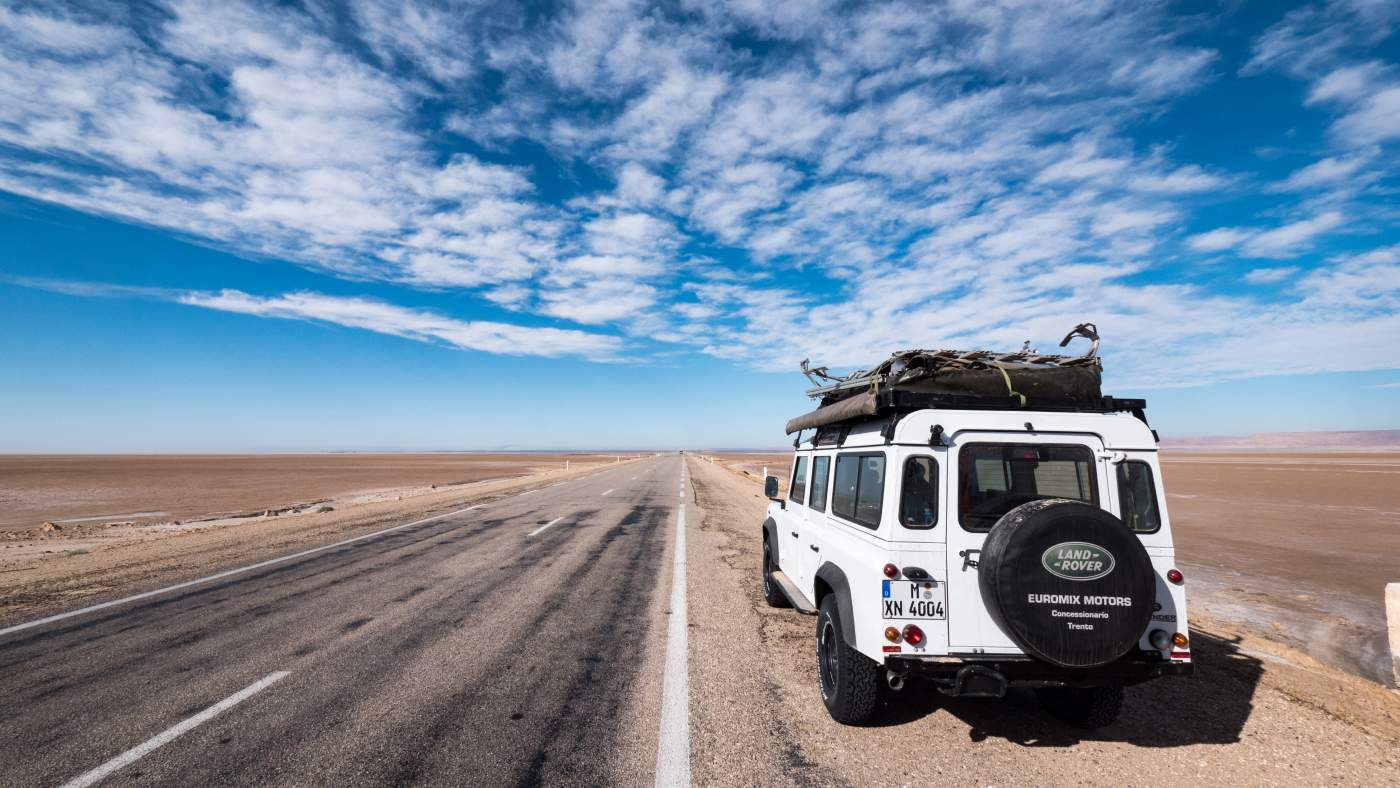
Mit dem Defender richtung süden auf unseren Geländewagentouren in Tunesien
Geländewagenreise Tag 3: Gafsa - Tozeur
Heute fahren wir teils offroad über einen kleinen Umweg in die Stadt Tozeur. Über die sogenannte Rommelpiste geht es nahe der algerischen Grenze über den ausgetrockneten Chot El Rahim, bis wir in unserem Camp in Tozeur ankommen.
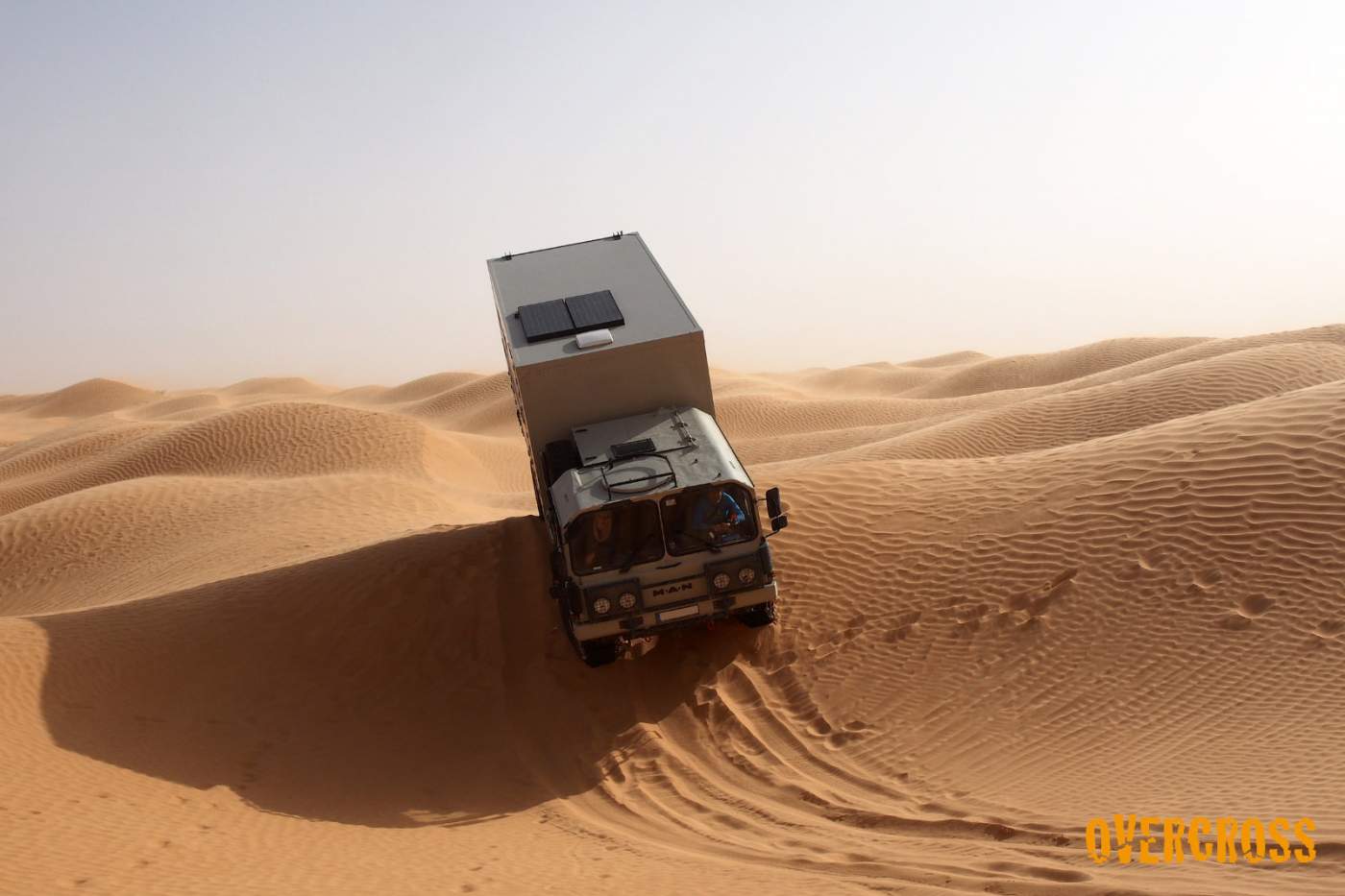
Auf Spurensuche in der Sahara mit dem Overlander Truck
Geländewagenreise Tag 4: Tozeur - Nefta (Wildcamp)
Über die ersten versandeten Pisten und Dünen fahren wir heute auf der Offroad Pur Auf Spurensuche in der Sahara einen kleinen Rundkurs um
Tozeur. Unser Ziel ist einer der Drehorte der
Star Wars Filme, wo wir gleich in der Nähe unser erstes
Wildcamp errichten. Wir kochen gemeinsam und genießen und den Abend zwischen Dünen
inmitten der Sahara. Am abendlichen Lagerfeuer lassen wir den erfahrenen
offroad Tag mit den erlernten Fahrtechniken Revue passieren.
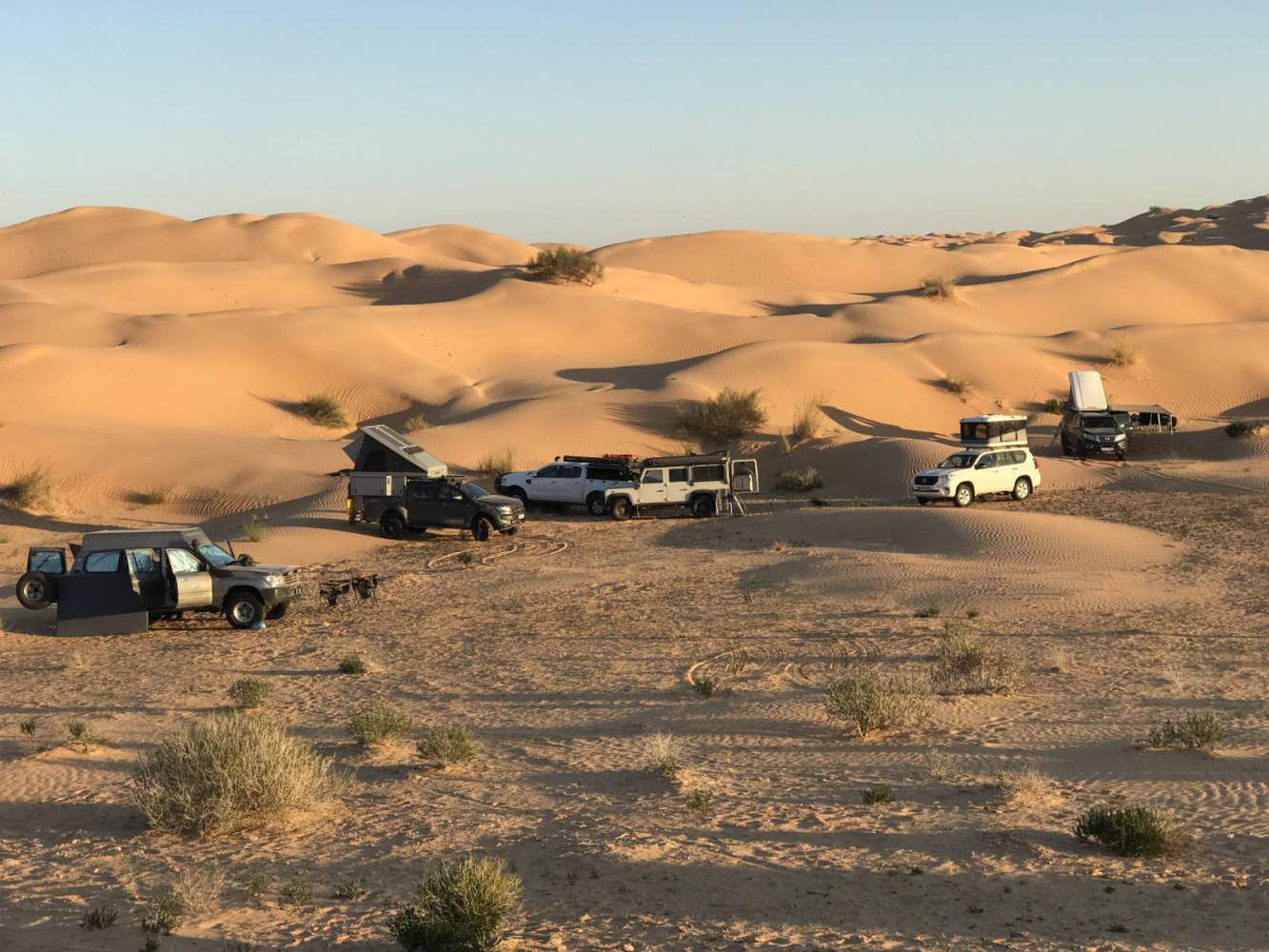
Geländewagen Camp Wagenburg in der Sahara zwischen den Dünen
Geländewagenreise Tag 5: Nefta - Douz
Morgens räumen wir nach einem ausgiebigen Frühstück unser Wildcamp zwischen den Dünen und fahren in Richtung der Oasenstadt Douz, die auch als Tor zur Sahara bekannt ist. Die Überquerung des Chott el-Jérid erfolgt auf der Dammstraße - es handelt sich hier um das größte Salzseengebiet in der Sahara. Im 14. Jahrhundert verschwanden hier über 1000 Kamele einer Karawane. In Douz stocken wir die Vorräte auf und haben Zeit für einen letzten Check vor der Wüste. Wir lassen den Abend am Feuer ausklingen, bevor wir am nächsten Tag mit den Geländewagen in die Wüste vordringen.
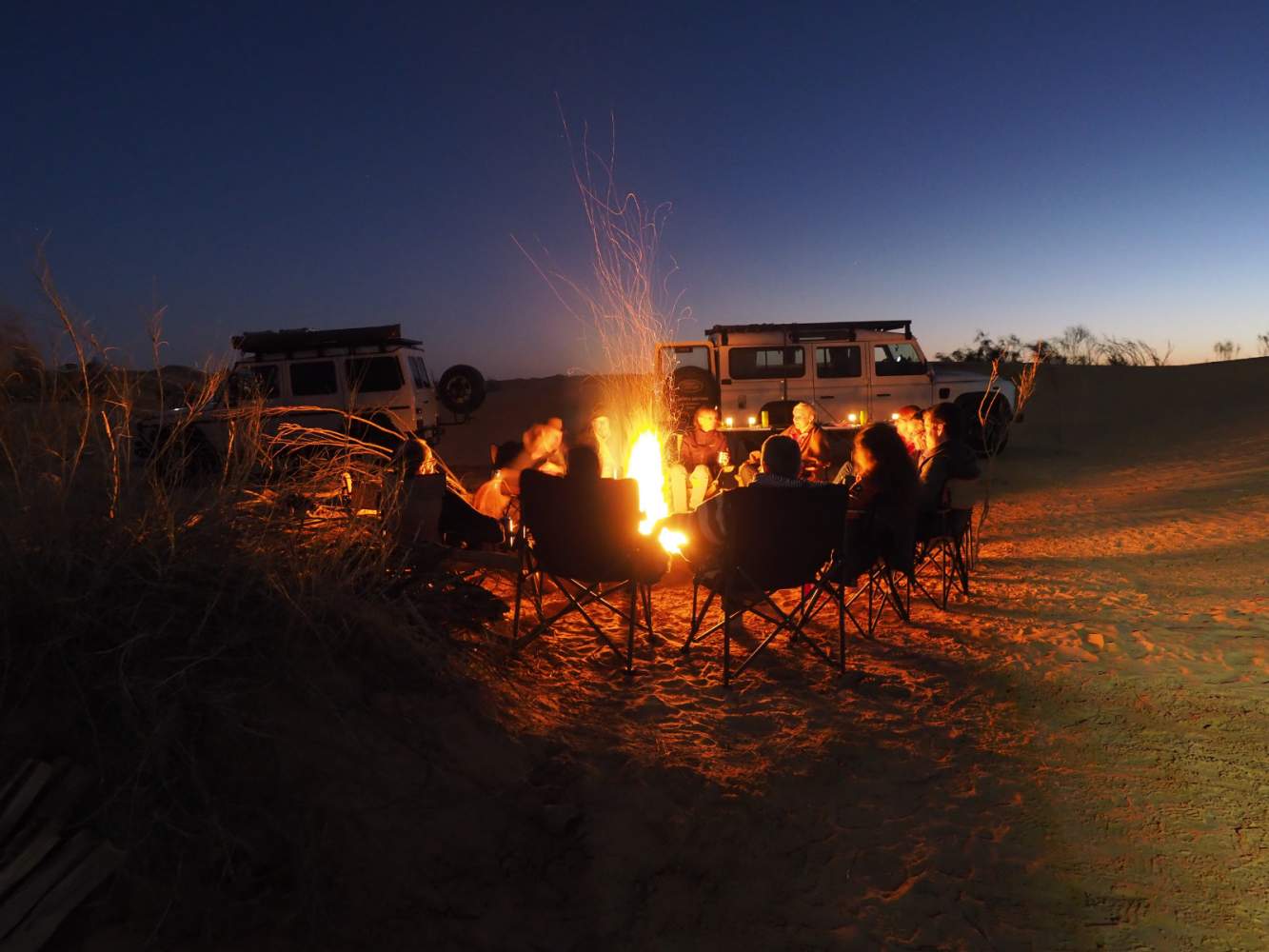
Gemeinsames Abendessen am Lagerfeuer auf den Geländewagenreisen durch Tunesien
Geländewagenreise Tag 6 - 9: Douz - Tembaine - Dekanis - Verlorener See - El Mida - Ksar Ghilane - Douz
Heute tauchen wir in die Weiten der Sahara ein und werden für die nächsten 4 Tage autark sein. Je nach Gegebenheiten vor Ort und Fahrkönnen der Gruppe werden wir die Route entsprechend anpassen und einige der bekanntesten Wegpunkte im südlich von Douz liegenden Gebiet des Grand Erg Oriental anfahren.
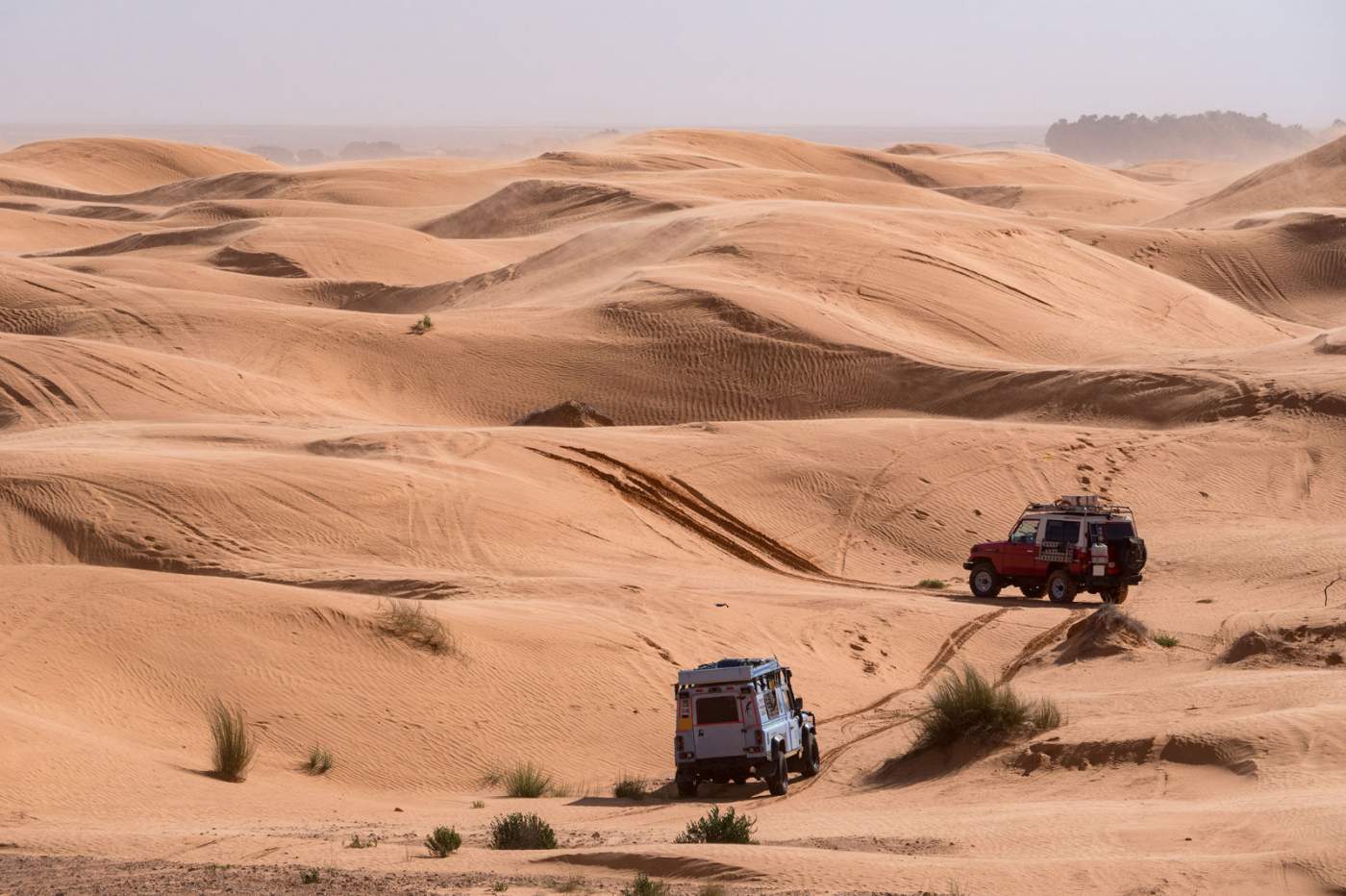
Sanddünen soweit das Auge reicht - Mit 4x4 power durch die Sahara auf unseren 4x4 Reisen
Geländewagenreise Tag 10: Ksar Ghilane
Den heutigen Tag lassen wir ganz entspannt angehen, wer möchte kann eine Dünenwanderung machen, in der warmen Quelle der Oase baden oder wer noch nicht genug hat kann mit uns und den Geländewagen über die Dünen zum alten römischen Fort fahren um die Romantik des Sonnenuntergangs über der Sahara zu genießen.
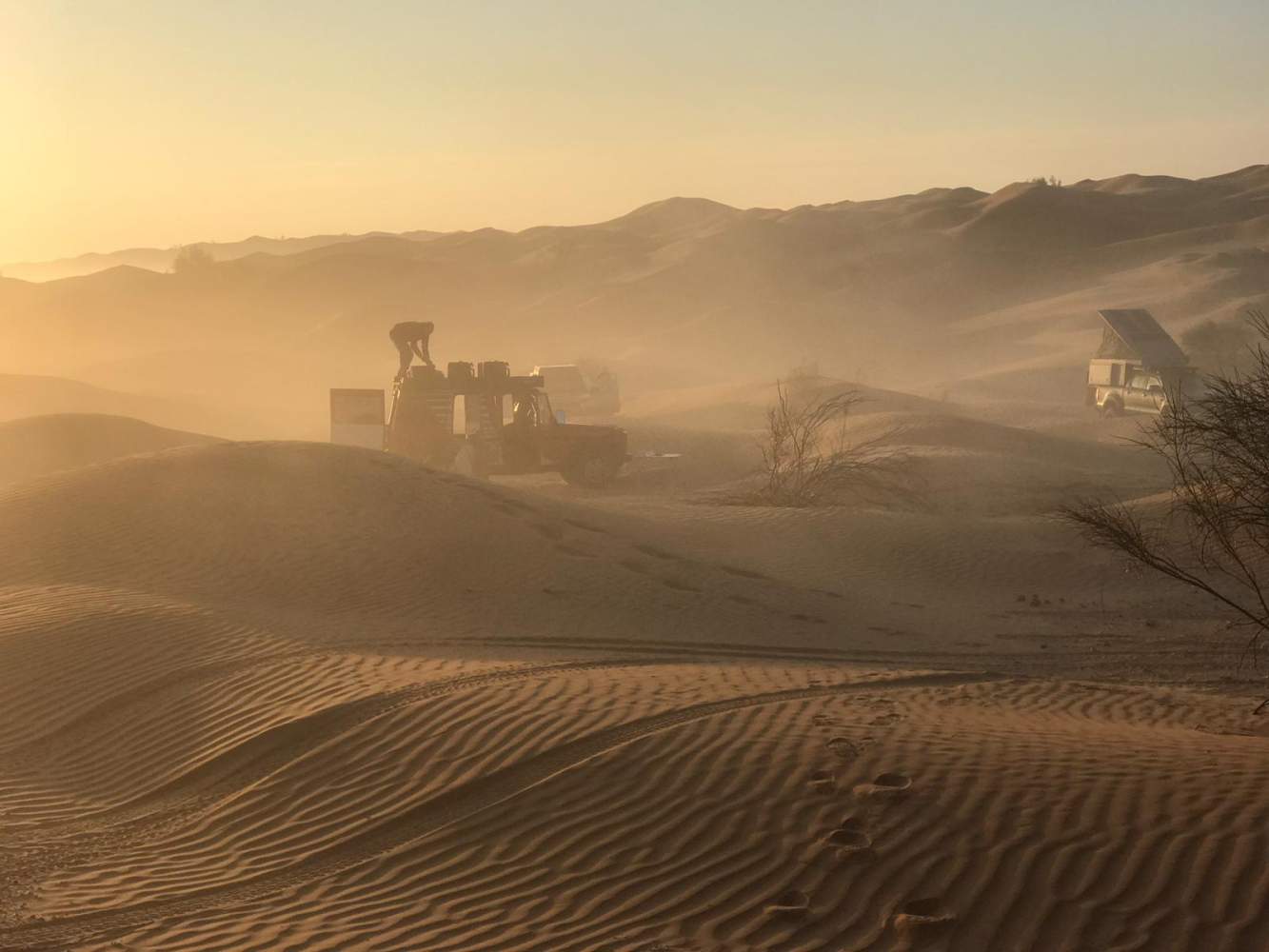
Aufbau des Camps nahe der Oase Ksar Ghilane während eines Sandsturms bei Sonnenuntergang
Geländewagenreise Tag 11: Ksar Ghilane - Matmata
Raus aus der Wüste und zurück in die Zivilisation. Heute nehmen wir leider schon Abschied vom Sand und von den Weiten der Wüste und fahren nach Sfax. Von hier aus bringt uns eine kleine Fähre auf die Insel Kerkennah wo wir die Nacht einfach wild an der Küste übernachten. Wir machen ein Feuer, genießen das BBQ und lassen die letzten Tage Revue passieren.
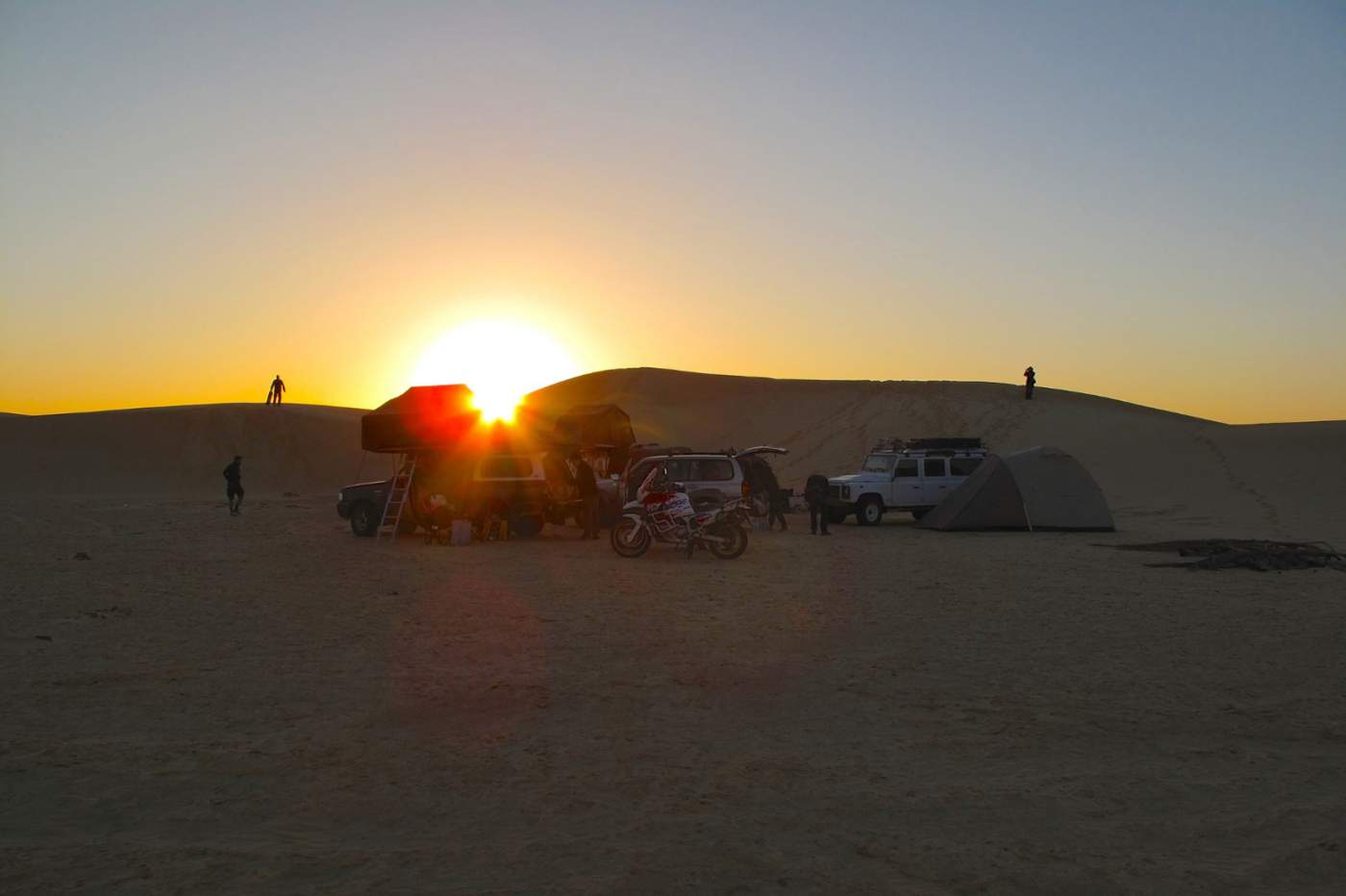
Camping in der Wagenburg zwischen den Dünen auf dem Geländewagenabenteuer
Geländewagenreise Tag 12: Sfax - Hammamet
Den Rest der Strecke fahren wir über Straße bis nach Hammamet zu unserem Hotel, von dem aus wir morgen nach Tunis zur Fähre starten werden.
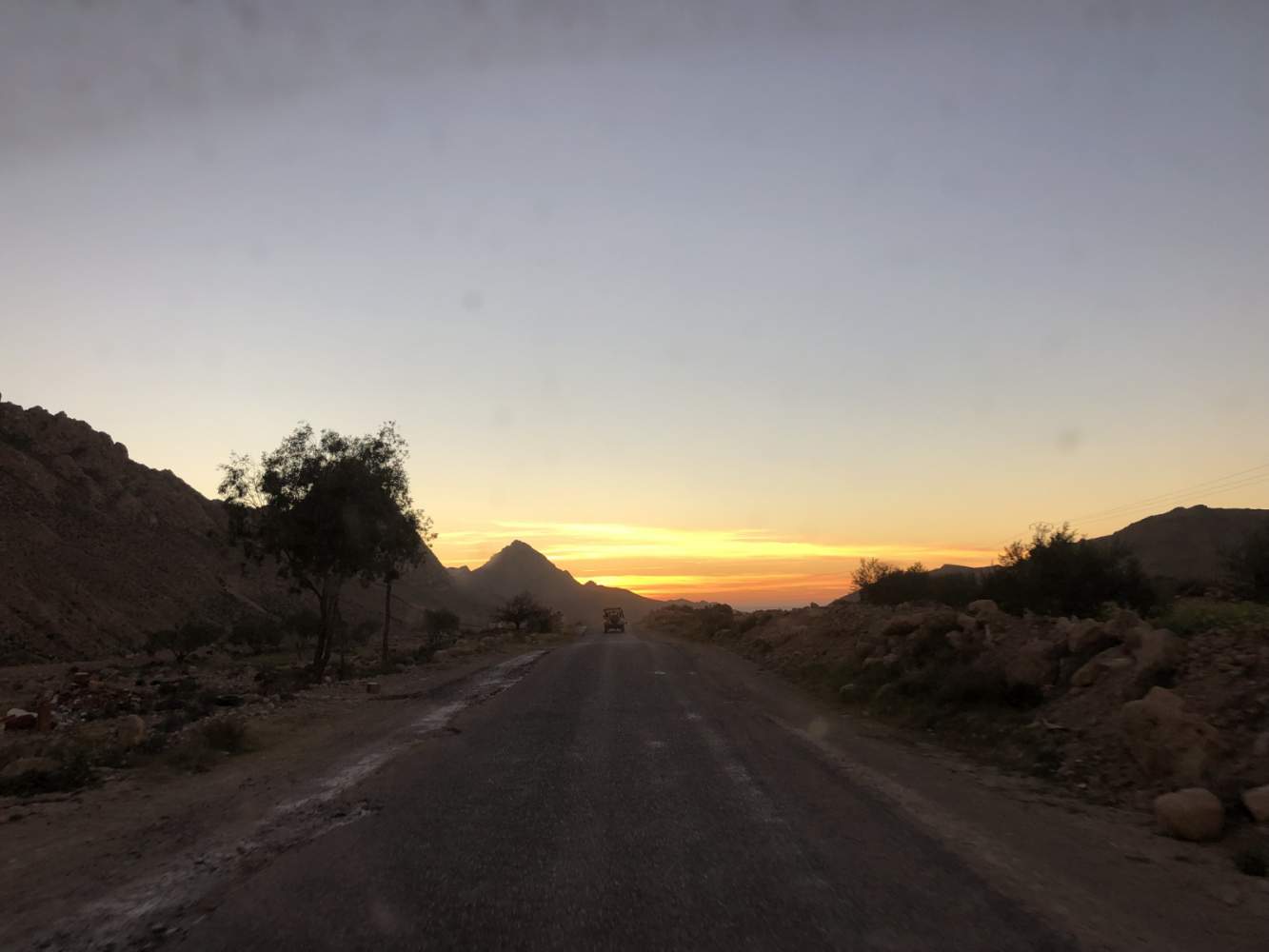
Geländewägen fahren Richtung Sonnenuntergang zurück nach Hammamet auf unseren 4x4 Reisen
Geländewagenreise Tag 13: Hammamet - Tunis
Auf den letzten Kilometern zur Fähre, die uns zurück nach Genua bringen wird, verabschieden wir uns vom reizvollen und vielfältigen Tunesien.
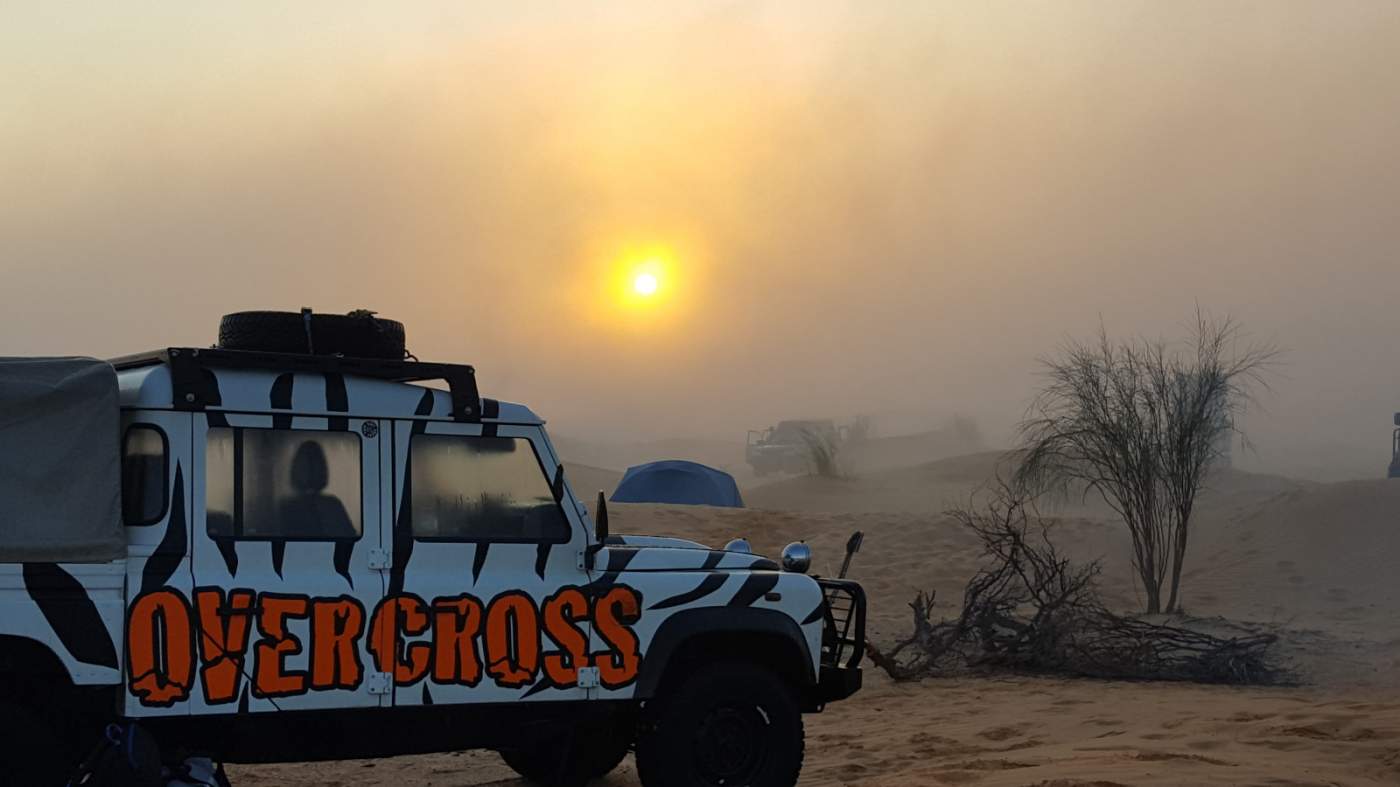
Mit dem Zebra Defender in der Wüste auf unseren Geländewagenreisen durch Afrika
Unsere 4x4 Mietfahrzeuge findest du Hier!
Hinweise:
- All unsere Reisebeschreibungen sind lediglich als Tourvorschlag zu verstehen. Der genaue Reiseverlauf kann an die jeweils aktuellen Gegebenheiten vor Ort angepasst werden, wobei wir natürlich stets bemüht sind den beschriebenen Reiseverlauf einzuhalten.
- Sollte die Mindestteilnehmeranzahl nicht erreicht werden, kann es in seltenen Fällen vorkommen, dass die Tour spätestens vier Wochen vor Reisebeginn abgesagt werden muss.












